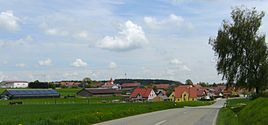Vogelthal
|
Vogelthal
City of Dietfurt an der Altmühl
Coordinates: 49 ° 0 ′ 1 ″ N , 11 ° 33 ′ 34 ″ E
|
|
|---|---|
| Height : | 494 m |
| Residents : | 115 (May 25 1987) |
| Incorporation : | July 1, 1972 |
| Postal code : | 92345 |
| Area code : | 08464 |
|
Vogelthal
|
|
Vogelthal is a district of the city of Dietfurt an der Altmühl in the Neumarkt district in Upper Palatinate , Bavaria .
location
Vogelthal is located on the plateau of the southern Franconian Jura in the Altmühltal Nature Park, southwest of Dietfurt an der Altmühl. From Amtmannsdorf, a road branches off to the east from Bundesstraße 299 to Vogelthal and on to the neighboring village of Arnsdorf.
history
Around 1180, Count Siboto von Falkenstein , married to a Sulzbach - Habsberger , owned three farms in Vogelthal according to the " Codex Falkensteinensis ". Later ownership passed to the Hirschberg Counts . In 1304, the last Count of Hirschberg , Gebhard VII., Stipulated in his will that his property, including Vogelthal, should go to the Eichstatt Bishop. When the count died in 1305, there was a dispute between the bishop and Bavaria over the inheritance; in the Gaimersheim verdict of October 19, 1305, the village was awarded to the bishop. In 1306, in a dispute with the royal provincial bailiff in Nuremberg, King Albrecht's ruling on September 8th also awarded the bishop the village court. The bishop transferred the bailiwick of the taverns of Töging , proven in the 15th century; so in 1415 mead Schenk (the Elder) was so invested . The taverns were also enfeoffed with goods.
In 1407 the Salbuch von Hirschberg recorded four vogtable farmsteads, three of which were barren. In 1417 the Murach people were wealthy in Vogelthal. Also in 1447 there is talk of four Hirschberger Höfe, one of which had previously belonged to the Altmühlmünster, a member of the Johanniterkommende. Another farm was probably transferred from the Murach to the bishopric in 1572. In 1471 six farmers paid interest to Hirschberg. In 1584 three courtyards of taverns came to the bishop when Tögings passed to the bishopric; they initially remained under the administration of the now episcopal judicial office Töging, later the caste office Hirschberg-Beilngries. Around 1640 a farm paid interest to the Benedictine monastery in Plankstetten . In 1644 the villagers were partly owner-occupied, partly subject to high esteem, partly to Dietfurt; a smaller property belonged to the Muggentaler to Hexenagger in the Schambachtal.
At the end of the 18th century, four properties were subordinate to the Hirschberg nursing office , two to the Töging episcopal judge's office, one to the Plankstetten monastery and another from at least 1326 to the Riedenburg Bavarian nursing office . With regard to marital imprisonment , the village belonged to Kottingwörth, as did the parish.
During the secularization , the lower bishopric, to which the judicial office of Töging and thus Vogelthal belonged, came to Grand Duke Archduke Ferdinand III. from Tuscany and 1806 to Bavaria and there to the regional court of Beilngries . In 1809 the tax district Amtmannsdorf was formed from Grögling, Amtmannsdorf and Vogelthal (from 1811 rural community ). In 1818 Vogelthal became an independent municipality again together with Grögling . In 1830 Vogelthal had 70 inhabitants with 30 properties, in 1944 140 inhabitants. Lying in the district office or district of Beilngries , the place joined the municipality of Dietfurt in the Altmühltal in the enlarged district of Neumarkt in the Upper Palatinate on July 1, 1972 during the Bavarian territorial reform , which also resulted in the dissolution of this district.
Church conditions
Vogelthal belonged to the original parish of Kottingwörth. From 1792 the place was temporarily assigned to the Catholic parish Paulushofen . The original St. Vitus village chapel was a small baroque building, erected in 1797, with a half-timbered roof turret from 1867. It was removed in 1954, but can still be seen as a painting on a house wall near its former location.
Today's village church of St. Willibald with a nave with an ornamentally painted wooden ceiling, with a sign , with a tower with a four-sided pointed helmet and an attached sacristy stands on the northern edge of the village and is dedicated to St. Willibald consecrated. It was created in 1953 by the architect Josef Elfinger , Ingolstadt , in the traditional type of the choir tower church .
societies
- Vogelthal volunteer fire brigade
- Vogelthal Riding Club
- Vogelthal Warrior Association
- Catholic rural youth movement Vogelthal
People related to Vogelthal
- Michael Wittmann (1914–1944), German SS Hauptsturmführer in the Waffen SS.
literature
- Friedrich Hermann Hofmann and Felix Mader (editor): The art monuments of Upper Palatinate & Regensburg. XII District Office Beilngries. I: Beilngries District Court. Oldenbourg, Munich 1908 (reprint 1982), p. 153.
- Felix Mader: History of the castle and Oberamt Hirschberg. Brönner & Daentler, Eichstätt 1940, p. 234f.
- Historical Atlas of Bavaria. Altbayern, Series I, Issue 16: Neumarkt. Franconia, series I, issue 6: Eichstätt. ( Digital collection of the Bavarian State Library )
- St. Willibald Vogelthal. In: Emanuel Braun: Fortified Church of St. Vitus Kottingwörth. - St. Johannes and Paulus Grögling - St. Michael Leising - St. Willibald Vogelthal. Schnell & Steiner, Munich, Zurich 1985, p. 18.
Web links
Individual evidence
- ↑ Bavarian State Office for Statistics and Data Processing (Ed.): Official local directory for Bavaria, territorial status: May 25, 1987 . Issue 450 of the articles on Bavaria's statistics. Munich November 1991, DNB 94240937X , p. 258 ( digitized version ).
- ^ Wilhelm Volkert (ed.): Handbook of Bavarian offices, communities and courts 1799–1980 . CH Beck, Munich 1983, ISBN 3-406-09669-7 , p. 557 .

